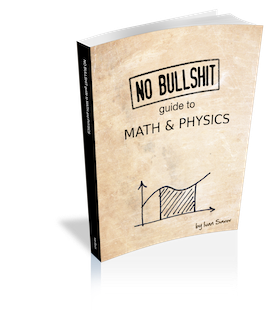The page you are reading is part of a draft (v2.0) of the "No bullshit guide to math and physics."
The text has since gone through many edits and is now available in print and electronic format. The current edition of the book is v4.0, which is a substantial improvement in terms of content and language (I hired a professional editor) from the draft version.
I'm leaving the old wiki content up for the time being, but I highly engourage you to check out the finished book. You can check out an extended preview here (PDF, 106 pages, 5MB).
Conclusion
The fundamental purpose of mechanics is to predict the motion of objects using equations. In the beginning of the chapter, I made the claim that there are only twenty equations that you need to know in order to solve any physics problem. Let us now verify this claim and review the material.
Our goal was to find $x(t)$ for all times $t$. However, there are no equations of physics which will tell us $x(t)$ directly. Instead, we have Newton's second law $F=ma$, which tells us that the acceleration of the object $a(t)$ is equal to the net force acting on the object divided by the object's mass. In order to find $x(t)$ starting from $a(t)$ we must use integration (twice).
We studied kinematics in several different contexts. We originally looked at kinematics problems in one dimension, and derived the UAM and UVM equations. We also studied the problem of projectile motion by decomposing it into two separate kinematics subproblems: one in the $x$ direction (UVM) and one in the $y$ direction (UAM). Later, we studied the circular motion of objects and stated equation $a_r=\frac{v_t^2}{r}$ which describes an important relationship between the radial acceleration, the tangential velocity and the radius of the circle of rotation. We also studied rotational motion using angular kinematics quantities $\theta(t)$, $\omega(t)$ and $\alpha(t)$. We defined the concept of torque and used this concept to write down the angular equivalent of Newton's second law $\mathcal{T}=I\alpha$. Finally, we studied the equation which describes simple harmonic motion: $x(t)=A\cos(\omega t + \phi)$ and showed the formula $\omega = \sqrt{ \frac{k}{m} }$, which is used to find the angular frequency of a mass-spring system.
We also discussed three conservation laws: the conservation of linear momentum law $\sum\vec{p}_{i} = \sum\vec{p}_{f}$, the conservation of angular momentum law $L_{i} = L_{f}$ and the conservation of energy law $\sum E_{i} = \sum E_{f}$. Each of these three fundamental quantities is conserved overall and cannot be created nor destroyed. Momentum calculations are used to analyze collisions, while energy formulas like equations $K=\frac{1}{2}mv^2$, $U_g=mgh$ and $U_s=\frac{1}{2}kx^2$ can be used to analyze the motion of objects in terms of energy principles.
As you can see, twenty equations really are enough for all of Mechanics. The next step for you should be to practice solving exercises in order to solidify your understanding.
